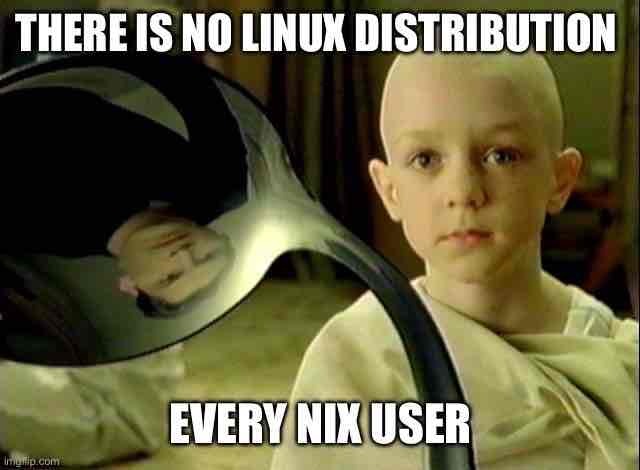When I read through the release announcements of most Linux distributions, the updates seem repetitive and uninspired—typically featuring little more than a newer kernel, a desktop environment upgrade, and the latest versions of popular applications (which have nothing to do with the distro itself). It feels like there’s a shortage of meaningful innovation, to the point that they tout updates to Firefox or LibreOffice as if they were significant contributions from the distribution itself.
It raises the question: are these distributions doing anything beyond repackaging the latest software? Are they adding any genuinely useful features or applications that differentiate them from one another? And more importantly, should they be?

I think it is a sign the Linux ecosystem is mature, boring is good in software in my opinion.

wouldn’t think so. automatic upgrades is as essential feature for desktop systems, yet they are nit really here. I can’t appear at the dozens of my friends (significant amount of them elder) to upgrade their systems every few weeks or a month, or when e.g. firefox gets a critical vulnerability fix

Automatic updates are there with the right distro. Which highlights the need to look around for the right distro for the use case.
Example being Opensuse Aeon - automatic updates - doesn’t even tell you it’s happening, just pops up “your system was updated” out of nowhere
Automatic rollback - if an update broke something you would never know, at boot the system will pick the previous snapshot with no user intervention
As far as the user is concerned you just have a working system; that it is the entire goal of that distro

Bring on the boring! Its what lets me daily Linux as a real alternative to windows. I love that my system gets constant updates, I get to pick when they install, it goes out of its way to NOT overwrite my preferences and settings, it maintains the look and feel I set it to, and it stays stable.

Pop_OS! is about to drop a whole new desktop environment (COSMIC) made from scratch that’s not just a fork of Gnome. Canonical tried that as well a while back with Unity although it was mostly still Gnome with extra Compiz plugins.
A lot of cool stuff is also either for enterprise uses, or generally under the hood stuff. Simple packages updates can mean someone’s GPU is finally usable. Even that LibreOffice update might mean someone’s annoying bug is finally fixed.
But yes otherwise distros are mostly there to bundle up and configure the software for you. It’s really just a bunch of software, you can get the exact same experience making your own with LFS. Distros also make some choices like what are the best versions to bundle up as a release, what software and features they’re gonna use. Distros make choices for you like glibc/musl, will it use PulseAudio or PipeWire, and so on. Some distros like Bazzite are all about a specific use case (gamers), and all they do is ship all the latest tweaks and patches so all the handhelds behave correctly and just run the damn games out of the box. You can use regular Fedora but they just have it all good to go for you out of the box. That’s valuable to some people.
Sometimes not much is going on in open-source so it just makes for boring releases. Also means likely more focus on bug fixes and stability.

Unity although it was mostly still Gnome with extra Compiz plugins
Don’t forget the added value of the Amazon ads!
No, not value for you, value for Canonical.


why have menus covering stuff up when you can just use keybinds?

@cerement I don’t have menus covering anything, they are pulldown menus, with respect to keybinds, there are only so many keys on a keyboard, and usually I want to actually produce input to some application with them, don’t care for OS to get in the way here either.

Hey, if you don’t think distributions are doing anything, you can always use Linux From Scratch.
Seriously though, most of the work done by good distros is specifically so you don’t notice things. They make a bajillion independent open source projects work together nicely. That’s something I’m glad I don’t have to do myself.

As someone who recently switched to Arch (btw) I finally figured out how much work the distros were doing in the background. Between default applications and configurations, there was a lot of stuff I had to learn to do on the fly. I’m happy with my system now though, since it’s just the way I wanted it to be.

For me distro’s role is to repackage things and then test them to check if they work together. Kinda like a premade sandwitch.

Yeah, I’d rather the distro be as boring as possible while the exciting stuff happens upstream.

Honestly, when you say
are these distributions doing anything beyond repackaging the latest software?
— I have to wonder what you think is so trivial about keeping your system current with latest bug fixes and security updates?
I don’t need or want a distro to radically reinvent itself with every release. I had enough of that fuckery with Windows, way back when — incidentally, also a direct reason I quit that OS. And seeing “big changes” like Ubuntu deciding to functionally deprecate deb packages is… unappealing to me as well.
There are probably sexier updates going on in DEs, but (insofar as a distro isn’t wedded to one particular desktop environment) I’m fine to let them hog that glamour.

You should use Arch, btw

It’s kind of in the word distribution, no? Distros package and … distribute software.
Larger distros usually do a quite a bit of kernel work as well, and they often include bugfixes or other changes in their kernel that isn’t in mainline or stable. Enterprise-grade distributions often backport hardware support from newer kernels into their older kernels. But even distros with close-to-latest kernels like Tumbleweed or Fedora do this to a certain extent. This isn’t limited to the kernel and often extends to many other packages.
They also do a lot of (automated) testing, just look at openQA for example. That’s a big part of the reason why Tumbleweed (relatively) rarely breaks. If all they did was collect an up-to-date version of every package they want to ship, it’d probably be permanently broken.
Also, saying they “just” update the desktop environment doesn’t do it justice. DEs like KDE and GNOME are a lot more than just something that draws application windows on your screen. They come with userspace applications and frameworks. They introduce features like vastly improved HDR support (KDE 6.2, usually along with updates to Wayland etc.).
Some of the rolling (Tumbleweed) or more regular (Fedora) releases also push for more technical changes. Fedora dropped X11 by default on their KDE spin with v40, and will likely drop X11 with their default GNOME distro as well, now that GNOME no longer requires it even when running Wayland. Tumbleweed is actively pushing for great systemd-boot support, and while it’s still experimental it’s already in a decent state (not ready for prime time yet though).
Then, distros also integrate packages to work together. A good example of this is the built-in enabled-by-default snapshot system of Tumbleweed (you might’ve figured out that I’m a Tumbleweed user by now): it uses snapper to create btrfs snapshots on every zypper (package manager) system update, and not only can you rollback a running system, you can boot older snapshots directly from the grub2 or systemd-boot bootloader. You can replicate this on pretty much any distro (btrfs support is in the kernel, snapper is made by an openSUSE member but available for other distros etc.), but it’s all integrated and ready to go out of the box. You don’t have to configure your package manager to automatically create snapshots with snapper, the btrfs subvolume layout is already setup for you in a way that makes sense, you don’t have to think about how you want to add these snapshots to your bootloader, etc.
So distros or their authors do a lot and their releases can be exciting in a way, but maybe not all of that excitement is directly user-facing.

I didn’t know systemd-boot loader could boot snapshots. Do you know if there’s a guide to set this up?
I’m not using tumbleweed anymore for a few reasons, but my system does have snapper taking snapshots, and I’m using systemd-boot loader instead of grub. But I don’t know how to make those work together.

There are 2 kinds of distributes. One that are on customization side and those on stability side.
For example Debian, Fedora, and arguably Arch are on stability side. They are intended for people that want things to work predictably and software to be packaged and shipped as the developer intended it. Customization or lack of it is up to the user.
Distributions like Manjaro, Zorin OS, Elementary OS, LMDE or even Linux XP are have a given goal to a pqr5icular customization. Either a set of tweaks, a particular look or even their own desktop environment or set of software they develop themselves.
This means that the first kind would have the most boring update, as they just ship new and correctly integrated software. Wwhilr the second kind would provide very nice customizations or patching of their own to their environment.

Since adopting a Flatpak and containerized workflow, the choice of distribution matters a lot less to me now than it did 10 years ago.
The majority of apps that I use everyday can be run from any host. And I can install fedora, arch, debian, or whatever I want as a container, whenever I want it, without any thought to my host system.
Ideally, Flatpak’s UX will continue to improve, and upstream app devs will continue to adopt it as an official support channel, which will improve overall security and confidence of the platform. Image-based, atomic distros will be further streamlined, allowing for even more easily interchangeable host images. At that point, traditional distros will be little more than an opinionated collection of command line tools and programming environments.

I think you are looking at work horse distros, like Ubuntu, Fedora, etc… That by now are heavily used for productive work, not personal use. So they favor stability and minor quality of life improvements over shiny new updates.
There’s plenty shiny new cutting edge distros out there that are innovating, e.g. Nix, Silverblue, VanillaOS, all the container focused ones CoreOS, Container OS, Flatcar Container Linux and probably dozens more newer ones I am not aware of .

Other than a few graphics, there is so little customization in Zorin that you can drop in the Ubuntu repositories and never notice the difference. And as far as from scratch goes, the first kernel I used as .98 or .99, not quite 1.0, cross compiled for Intel on a Sparc platform, then you had to spend another three days compiling the GNU userland, and then another couple of days for Xorg, at which point you had a mostly usable system.

A distro is corposed of:
- an installer
- base system (bootloader, filesystems, service runner, DE, basic apps, settings)
- packet manager and packaged software
- an updater between releases
The biggest things you notice are updated packages. Many of the base-system differences aren’t even pushed to updated installations. Most of what the user sees as °the os° is the DE anyway.

Since I started using the Nix package manager and switched to NixOS, the notion of a “Linux distribution” faded into little more than “A bootloader + the Linux kernel + some userspace programs”.


The same happens with any of the new immutable distributions. It’s just less effort as you do not need to do the nix configuration dance anymore.

a shortage of meaningful innovation
Well… a distribution IS a selection of packages and a way to keep them working together. Arguably the “only” innovation in that context is HOW to do that and WHICH packages to rely on. For the first, the “latest” real change could be considered immutable distributions, as on the SteamDeck, and declarative setup, e.g. NixOS. For the second… well I don’t actually know if anybody is doing that, maybe things like PrimTux for kids at schools in France?
Anyway, I agree but I think it’s tricky to be innovative there so let me flip the question, what would YOU expect from an innovative distribution?
Well I’d like to see distros doing things to improve UX (which they now seem to have completely left to DEs). For example I remember when Ubuntu released their Hardware Drivers tool. It was samall but a super useful addition that made life easier for millions of users. But nowadays I see less app/utility contributions by distros.
